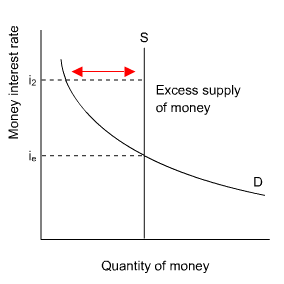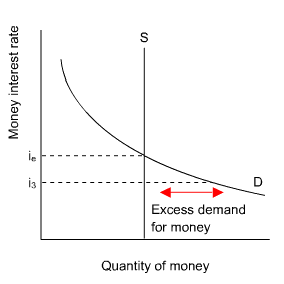- CFA Exams
- 2024 Level I
- Topic 2. Economics
- Learning Module 12. Monetary and Fiscal Policy
- Subject 2. The Demand for and Supply of Money
Seeing is believing!
Before you order, simply sign up for a free user account and in seconds you'll be experiencing the best in CFA exam preparation.
Subject 2. The Demand for and Supply of Money PDF Download
At any given interest rate, the amount of wealth that households and businesses desire to hold in the form of money balances, either as cash or any other highly liquid form of value (such as checking accounts), is called the demand for money.



Rnom = Rreal + Rinflation + risk premium
People hold (demand) money to conduct transactions, to deal with emergencies (precautionary motive), and for speculative activities.
There is an inverse relationship between the demand for money and interest rates when all other influences on the amount of money that people wish to hold remain the same.

A rise in the interest rate brings a decrease in the quantity of money demanded. A fall in the interest rate brings an increase in the quantity of money demanded.
The money supply schedule is vertical since domestic supply of money is determined by the central bank and reserve requirements. The supply of money is not affected by changes in the interest rate.
Money market equilibrium occurs when people are willing to hold all the money supplied by the monetary authorities at the prevailing interest rate; the supply of money equals the demand for money. It occurs at ie in the diagram.

However, disequilibrium exists at the interest rate i2.

People are not willing to hold all the money supplied by the monetary authorities as money balances. Instead, they demand high-interest earning assets such as bonds. This will increase the price of bonds, which in turn reduces their interest yield, driving i2 down towards ie and eventually restoring equilibrium.
Disequilibrium also exists at the interest rate i3.

People would like to hold more money balances than the monetary authorities are willing to supply. The resultant low demand for bonds reduces their prices, thus increasing their interest rate (yield), and slowly restores equilibrium at ie.
The Fisher Effect
The nominal rate of interest is comprised of three components:
- A real required rate of return.
- A component to compensate lenders for future inflation.
- A risk premium to compensate lenders for uncertainty.
User Contributed Comments 0
You need to log in first to add your comment.

Your review questions and global ranking system were so helpful.

Lina
My Own Flashcard
No flashcard found. Add a private flashcard for the subject.
Add